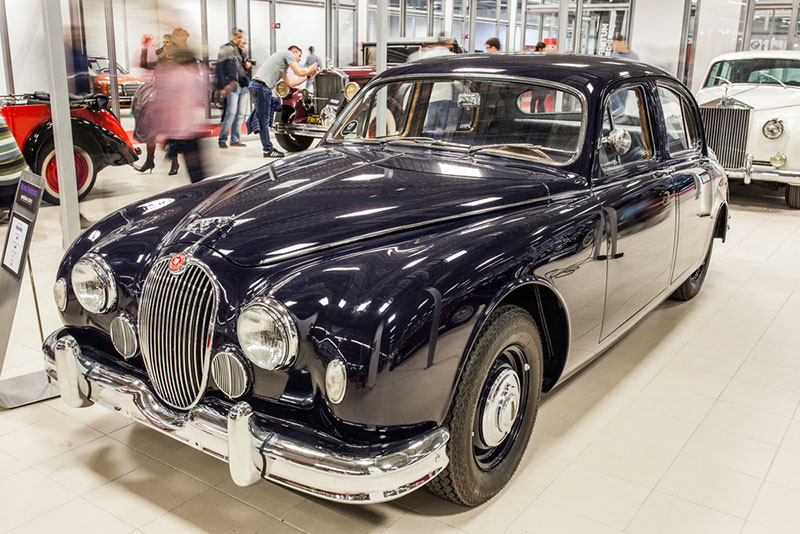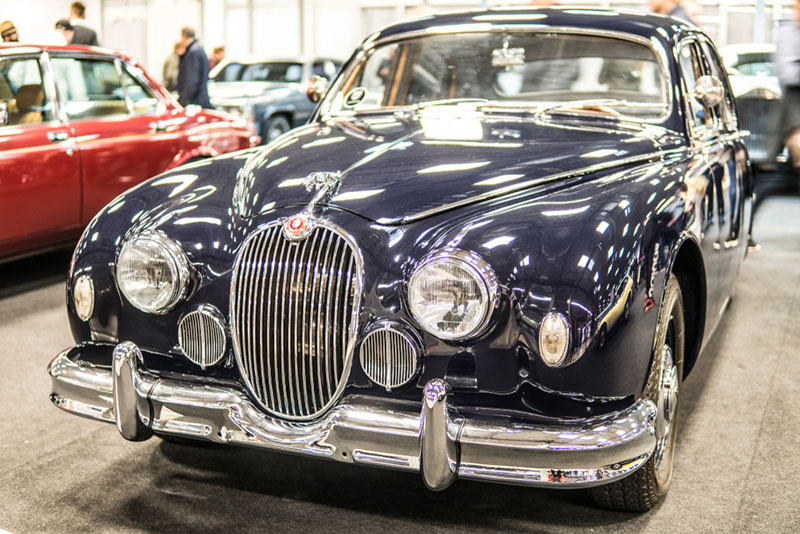Sell A Classic Car Jaguar Mark II. The classic Jaguar Mark II is a medium-sized saloon car built from late 1959 to 1967 by Jaguar in Coventry, England. Twelve months before the announcement of the XJ6 the 2.4 Litre and 3.4 Litre Mark 2 models were renamed to Jaguar 240 and Jaguar 340 respectively. The previous Jaguar 2.4 Litre and 3.4 Litre models were made between 1955 and 1959 and have been identified as Mark 1 Jaguars since Jaguar produced this Mark 2 model. Until the XJ, Jaguar’s post-war saloons were usually denoted by Roman numerals (e.g. Mark VII, Mark VIII) while the Mark 2 used Arabic Numerals, denoted on the rear of the car as “MK 2”.
Classic Jaguar Mark II
XK Engine
Adhering to Sir William Lyons’ maxim of “grace, pace, and space”, the Mark 2 was a fast and capable saloon.
It came with a:
- 120 bhp (89 kW; 120 PS) 2,483 cubic centimetres (152 cu in)
- 210 bhp (160 kW; 210 PS) 3,442 cubic centimetres (210 cu in)
- 220 bhp (160 kW; 220 PS) 3,781 cubic centimetres (231 cu in) Jaguar XK engine.
The 3.8 is similar to the unit used in the 3.8 E-Type (called XKE in the USA), having the same block, crank, connecting rods and pistons but different inlet manifold and carburation (two SUs versus three on the E-Type in Europe) and therefore 30 bhp (22 kW) less.
The head of the six-cylinder engine in the Mark 2 had curved ports compared to the straight ports of the E-Type configuration.
The 3.4 Litre and 3.8 Litre cars were fitted with twin SU HD6 carburetors and the 2.4 Litre with twin Solex carburetors.
Some explanation is required concerning the claimed bhp figures are shown above. Jaguar used gross bhp figures throughout the production period of the Mk II and 240/340 models.
A direct conversion into DIN bhp is not possible, but we know that the 3.8 Mk II engine developed around 190 bhp DIN.
This compares with the later 4.2 XJ6 engine which also gave around 190 bhp DIN or 245 gross bhp, according to Jaguar, both being for 8:1 compression engines.
The explanation was that the lower peak for the XJ6 4.2 engine meant that the bhp was being delivered at less rpm, for the same output.
The camshaft timing and inlet and exhaust valve sizes were the same for the 2.4,3.4,3.8 Mk II and XJ6 4.2 engines, so the engines throttled themselves sooner in the bigger engine sizes.
The later 4.2 XJ6 engines had:
- Special induction pipes that crossed over between the inlet and exhaust sides of the engine
- Reduced bhp to around 170 bhp on later production.
Body
Compared to the Mark 1, the appearance of the car was transformed by:
- An increase of 18% in cabin glass area greatly improving vision.
- Re-engineering above the waistline, slender front pillars allowing a wider windscreen and the rear window almost wrapped around to the enlarged side windows now with the familiar Jaguar D-shape above the back door and fully chromed frames for all the side windows.
- The radiator grille was amended and larger side, tail and fog lamps repositioned
- Inside a new heating system was fitted and ducted to the rear compartment (although still notoriously ineffective).
- An improved instrument layout that became standard for all Jaguar cars until the XJ series II of 1973.
Mechanical changes
- The front suspension geometry was rearranged to raise the roll center and the rear track widened.
- Four-wheel disc brakes were now standard
- Power steering, overdrive or automatic transmissions could be fitted now at an extra cost
- The 3.8 Litre was supplied fitted with a limited-slip differential.
- The Mark 2 was over 100 kg heavier than the 2.4 / 3.4 cars.
Daimler 2.5 V8 and V8-250
A popular luxury derivative fitted with Daimler’s own 142 bhp (106 kW; 144 PS) 2½-litre V8 it sold well from 1962 to 1967 as a Daimler 2.5 V8.
In late 1967 it was re-labeled V8-250 to match Jaguar 240.
As well as being significantly more powerful than the 2.4-litre XK6 the more modern Daimler engine was:
- Lighter by about 150 lb (68 kg)
- Shorter which reduced the mass over the front wheels and so reduced understeer during hard cornering.
These cars were recognizable by:
- The characteristic Daimler wavy fluting incorporated in the chrome radiator grille and rear number plate lamp cover
- Their smoothness and the sound of their V8 engine.
- They are distinctive exterior and luxury interior fittings.
The 2.5 V8/V8-250 is a four-door saloon which was produced by The Daimler Company Limited in the United Kingdom from 1962 to 1969.
It was the first Daimler car to be based on:
- A Jaguar platform
- A unit body
- Last Daimler car to feature a Daimler engine after the company was bought from the Birmingham Small Arms Company by Jaguar Cars in 1960
The engine is the hemispherical head V8 designed by Edward Turner and first used in the Daimler SP250 sports car.
Daimler had entered the medium-sized saloon market in 1932 with the Daimler Fifteen but left the market with the end of production of the Conquest in 1957.
Attempts to re-enter the market with Turner’s 2.5-litre V8 included the development of the DN250 based on the Vauxhall Cresta PA’s unibody
This was later discontinued before Jaguar’s purchase of Daimler, and the DP250 two-door saloon based on the SP250 was discontinued by Jaguar after it bought Daimler.
Despite claiming an interest in expanding Daimler’s markets, Jaguar had bought Daimler primarily to:
- Expand their production facilities
Apart from replacing the DK400B limousine with the Majestic Major-based DR450, Jaguar had done little to develop new Daimler models.
Stratstone Ltd. pressed Jaguar to develop a medium-sized saloon to replace the Conquest, which Jaguar agreed to do in exchange for Stratstone dropping their Volkswagen franchise.
Daimler’s development of the 2.5-litre saloon was initially given few resources.
The first prototype was based on an:
- Old Jaguar Mark 1 unibody that had been abandoned outside one of the factory buildings
Once the concept had been proven, a new prototype based on a Mark 2 body shell was built.
The Daimler V8 engine was:
- More compact and lighter than the Jaguar XK6 engine used in the Mark 2
It weighed approximately 1 long cwt (51 kg) less.
Spring and damper settings were revised accordingly to suit the altered weight distribution.
Re-Designs
- The engine sump had to be redesigned to fit between the Mark 2’s front suspension units and around one of its cross members
- New exhaust manifolds were designed to fit in the engine bay
- The water pump and cooling fan were relocated
- Different air filters were used
- The cylinder head fasteners were changed from studs to set bolts to allow the heads to be removed while the engine was still in the car
- The radiator fan was driven through a viscous coupling unit that slipped progressively with increased engine speed, which reduced noise from the fan.
The Daimler’s Borg-Warner Type 35 automatic transmission was smaller and lighter than the units used on the Mark 2 and had strong engine braking in each gear range.
As a result of being built with the unit body of the Jaguar Mark 2, the 2.5-litre saloon became the first Daimler motor car without a separate frame.
The Daimler 2.5 V8 (or 2½-litre V8) was a four-door saloon produced in Coventry, England by Daimler
It was launched late in 1962.
It was essentially a rebadged Jaguar Mark 2 fitted:
- Daimler’s 2.5-litre V8 engine and drive-train
- A Daimler fluted grille
- Rear number plate surround
- Distinctive wheel trims
- Badges
- Interior details including a split-bench front seat from the Jaguar Mark 1
- Black enamel steering wheel
Special interior and exterior colors were specified.
Most cars were fitted with:
- Power-assisted steering but it was optional.
- The automatic transmission was standard; manual, with or without overdrive, became an option in 1967.
2.5 V8
The 2.5 V8 was the first Jaguar designed car to have the Daimler badge.
In April 1964 the Borg-Warner Type 35 automatic transmission was replaced by a D1/D2 type
This was also by Borg-Warner.
Three years after its launch, a Daimler 2½-litre saloon with automatic transmission tested by Britain’s Autocar magazine in May 1966 had a:
- Top speed of 112 mph (180 km/h)
&
- Could accelerate from 0-60 mph (97 km/h) in 13.6 seconds.
An overall fuel consumption of 19.0 miles per imperial gallon (14.9 L/100 km; 15.8 mpg? the US) was achieved.
The test car was priced in the UK at £1,647 including taxes
Rover’s 3-litre with automatic transmission was retailing for £1,770.
At the end of 1965:
- The final drive ratio had been changed from 4.55:1 to 4.27:1
This addressed complaints that the car as launched in 1963 had needed to exceed its recommended rev limit in order to reach its top speed with a corresponding penalty in fuel consumption and engine noise and wear.
The testers found the car:
- Refined and well equipped with efficient, if rather heavy, brakes.
- Having a well-matched engine and transmission
- Quiet and smooth but with poor low-speed torque.
A manual transmission, with or without an overdrive unit usable with the top gear, became available on British 2.5 V8 saloon in February 1967 and on export versions the following month.
Cars optioned with the overdrive had the original 4.55:1 final drive ratio
Daimler V8-250
V8-250
Produced from October 1967 to 1969, the V8-250 was a minor face-lift and re-labeling of the 2.5 V8 saloons and differed in relatively small details:
- Slimline bumpers and over-riders (shared with the Jaguar 240/340 relabelled at the same time)
- Negative-earth electrical system,
- An alternator instead of a dynamo and twin air cleaners
- One for each carburetor
Other new features included:
- Padding over the instrument panel
- Padded door cappings and ventilated leather upholstery
- Reclinable split-bench front seats and a heated rear window
- Power steering and overdrive were optional extras.

Market Placement
Aside from the smoother and more powerful engine and a number of external markers the Daimler V8-250 was simply a more luxuriously finished Jaguar 240.
The 250’s place in the Jaguar range was always ill-defined.
Whilst historically Daimler had been a genuine luxury and super-luxury brand the 250, though far better equipped than the base-model Jaguar 240, lacked some interior appointments found on the 340.
The Daimler 250’s engine, being a V8 (in its home market a prestige feature), producing 142 bhp (106 kW)—in between the outputs of the 2.4- and 3.4-litre six-cylinder engines. The V8-250 was a car with a high prestige badge sitting in the middle of its parent company’s range.
End of production
Jaguar replaced its range of saloons—the 240, the 340, the 420, and the 420G—with the XJ6 at the end of 1968.
The company launched the XJ6-based Daimler Sovereign the following year to replace the Daimler saloons—the 240-based V8-250 and the 420-based Sovereign.
Henceforth all-new Daimlers would be re-badged Jaguars with no engineering links to the pre-1960 Daimler.
More than 17,600 units were sold; by 1995 the 250 was still the best-selling car in Daimler’s history.
240 and 340
Sometime on or about September 1967 the 2.4 Litre and 3.4 Litre Mark 2 cars were rebadged as the 240 and 340 respectively.
However, there exists documentation of at least one Mark 2 car manufactured in May 1967 and rebadged as “340.”
The 3.8 Litre model was discontinued. The 240 and 340 were interim models intended to fill the gap until the introduction of the XJ6 in September 1968.
The 340 was discontinued on the introduction of the XJ6 but the 240 continued as a budget-priced model until April 1969; its price of £1364 was only £20 more than the first 2.4 in 1956.
Output of the 240 engine was increased from 120 bhp (89 kW; 120 PS) @ 5,750 r.p.m. to 133 bhp (99 kW; 135 PS) at 5,500 rpm. and torque was increased.
It now had a:
- Straight-port type cylinder head and twin HS6 SU carburetors with a new inlet manifold.
- Automatic transmission upgraded to a Borg-Warner 35 dual drive range
- Power steering by Marles Varamatic was now available on the 340
- Servicing intervals were increased from 2,000 miles (3,200 km) to 3,000 miles (4,800 km)
- A slight reshaping of the rear body and slimmer bumpers and over-riders were fitted.
For the first time, the 2.4 liter model could exceed 100 mph, resulting in a slight sales resurgence.
The economies of the new 240 and 340 models came at a cost.
The changes included:
- The leather upholstery was replaced by Ambala leather-like material
- The tufted carpet was used on the floor
- Replacement of the front fog lamps with circular vents and optional fog lamps for the UK market.
The sales price was reduced to compete with the Rover 2000 TC.
Production
Four forward speeds and (electric) overdrive
Mark 2: 83,976 produced between 1959 and 1967
They were split as follows:
- 2.4 Litre – 25,1733.
- 2. 4 Litre – 28,666
- 3.8 Litre – 30,141
240 and 340: 7,246 produced between 1967 and 1969.
It was split as follows
- 240 – 4,446340 – 2,788380 – 12 (not a standard production option)
The XJ6 was introduced in September 1968.
Performance
A 3.4 Litre with automatic transmission tested by The Motor magazine in 1961 had a top speed of 119.9 mph (193.0 km/h).
It could accelerate from 0-60 mph (97 km/h) in 11.9 seconds.
A touring fuel consumption of 19.0 miles per imperial gallon (14.9 L/100 km; 15.8 mpg?US) was recorded.
The test car cost £1951 including taxes of £614.
A 3.8 Litre with the 220 bhp engine was capable of accelerating from:
- 0-60 mph (97 km/h) in 8.5 seconds
- And could reach a top speed of 125 mph (201 km/h).
Influence on modern Jaguars
The Mark 2’s body lines, derived from the Mark 1, and overall layout proved sufficiently popular over time to provide an inspiration for the Jaguar S-Type introduced in 1999.
Portrayal in media
Jaguar Mark 2
The Mark 2 gained a reputation as a capable car among criminals and law enforcement alike
The 3.8 Litre model being particularly fast with its:
- 220 bhp (164 kW) engine
- Driving the car from 0-60 mph (97 km/h) in 8.5 seconds
- Top speed of 125 mph (201 km/h)
- Enough room for five adults.
They were popular as getaway cars and Police Cars in the U.K.
The Mark 2 is also well known as the car driven by fictional TV detective Inspector Morse played by John Thaw.
In the 1987 British film Withnail and I, a light-grey Mark 2 in very poor condition serves as the main transport for the duo.
Selling your Jaguar Mark II? or want a valuation?
Then please call us today at sell a classic car, we are the no hassle way to sell any classic car including your Jaguar Mark II. As a long time licensed and bonded California auto dealership, we will take care of all the paperwork for the sale of your car ….. properly take care of all the paperwork that is, with no car left still registered in your name; we will give you a fair and no BS immediate cash offer for the car; imagine no advertising costs, no dealing with “tire kickers”, no bad checks, no non-existent wire transfers, no waiting for your money and probably most importantly, no strangers at your home or in your business .. period.
We will also arrange the immediate professional pick up and transportation of your car by a licensed auto shipper from anywhere in the continental United States. Ultimately, we are one of the quickest, safest and easiest ways to sell your classic car today.
Sell A Classic Car Jaguar Mark IIWe have the knowledge and power to execute the deal immediately, so if you want some friendly advice or just a chat about how to sell us your Jaguar Mark II then don’t hesitate to call us at (424)383-8333 now!

